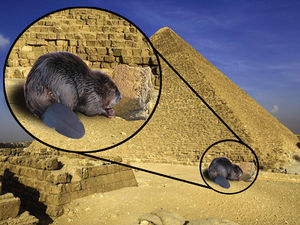UnNews:Proof giant beavers built pyramids, Egyptians had 3D graphics
5 October 2009
EGYPT, The Desert -- In February of 1838, Sir Perfunctory Giblets, third Earl of Retch, was casting about in the ruins of fourth dynasty Egyptian Pharaoh Menkaures' mortuary temple. He uncovered a small slab of granite with unusual depictions of what appears to be rodents pushing stones. This discovery led his ouster from the community of respectable scientists, and a legacy of being a silly person.
The astute proto-archeologist wrote in his field notes, "The relief shows what appears to be a beaver moving rocks about, as the pyramid of Menkaures is being constructed in the background. However, this is out of keeping with the current state of drawing figures at this time, which consists of crude two dimensional depictions. The concept of perspective in art hadn't been discovered until the Renaissance period. Curious, indeed."
After an astounding presentation to the Royal Academy for Sciences in London, members demanded he produce this tablet for examination. After much confusion about shipping orders, the location of the evidence was found. Unfortunately, it was in temporary storage at the home of Bridget Clougherty when she was killed, and the tablet swept out to sea by the Great Molasses Flood of 1919. History remembers the Earl as an eccentric, lying bastard with a penchant for zero-variable calculus. History remembers Ms. Clougherty less well.
Today there is some debate about the graphical capabilities of some ancient cultures. According to world history expert and scholar Alan Greenspan, "In fact,, Greek statesman in the 420s BC Alcibiades had paintings in his house designed based on skenographia, or three dimensional-appearing stage art, but the idea of perspective in graphical representation was certainly not invented when these ruins were built. As for the giant beavers, that's a little out of my field."
Fast forward to present day digs at the same site, and Dr. Zahi Hawass brushes sand from an approximately one meter square slab of granite with depictions of the flat-tailed behemoths and ancient writings.
When translated, the accompanying hieroglyphs read as an instruction manual for using giant beavers to move heavy blocks in construction of monumental architecture. Neither evolution nor intelligent design explain the sudden appearance in the fossil record of the Giant Egyptian Beaver in the second millennium BC. The soundest speculation to date is Dr. Hawass' theory that, "they (Giant Beavers and three-dimensional graphics) were introduced to early Egyptian culture by aliens from another planet. Clearly they came from out of the space."
Sources[edit | edit source]
- Dr. Sigmund Freud "Sometimes a beaver is just a beaver" Bangor Daily Banner, October 4, 2009
- Kenan and Lewis "Beavers built the Egyptian pyramids (YouTube Video)" YouTube, May 5, 2011
